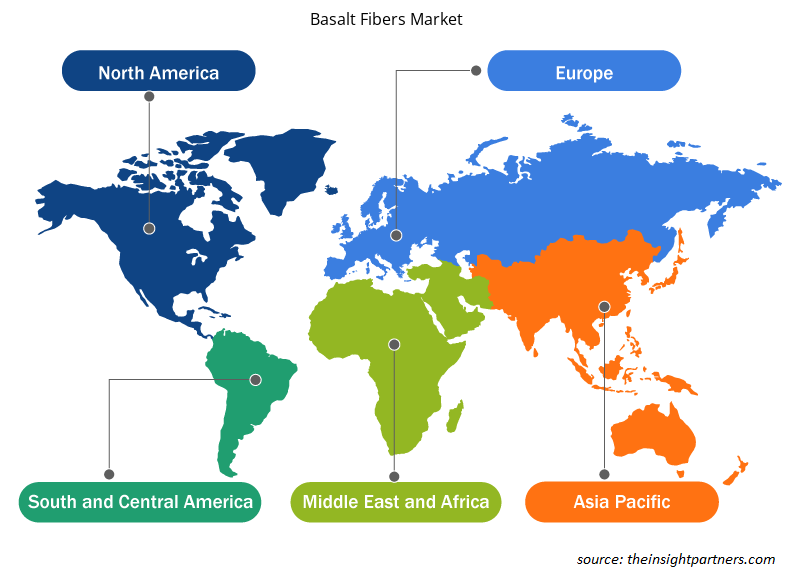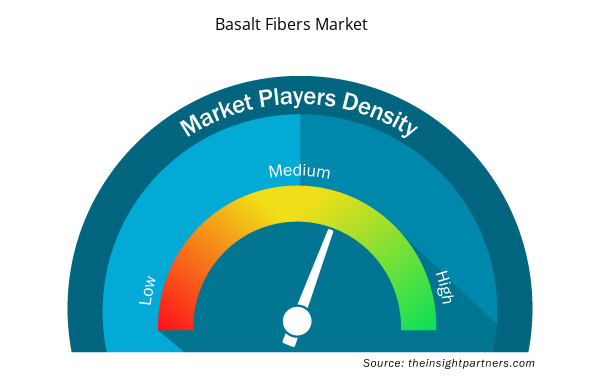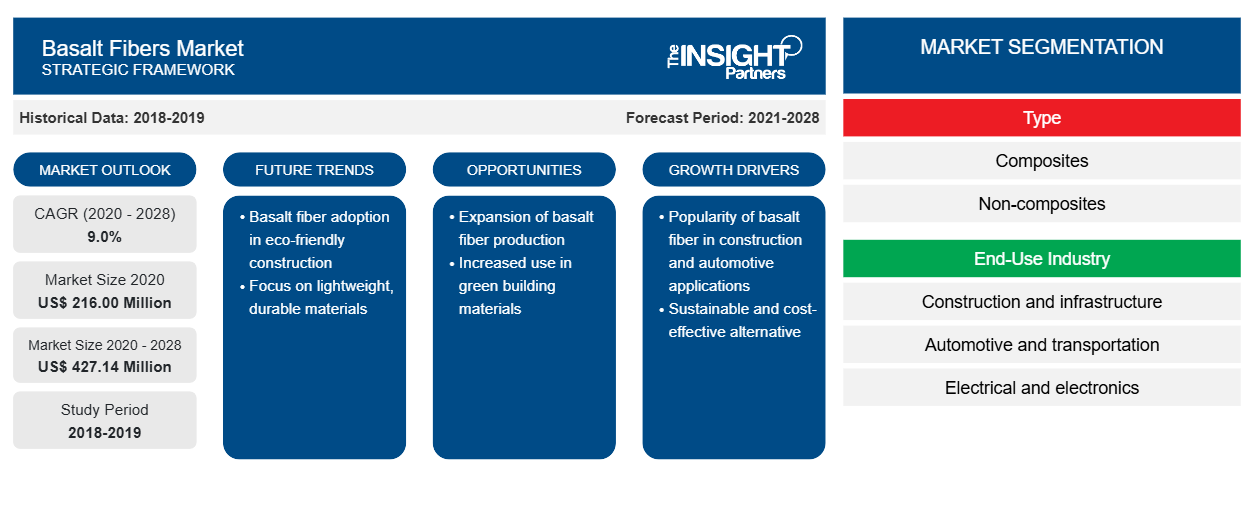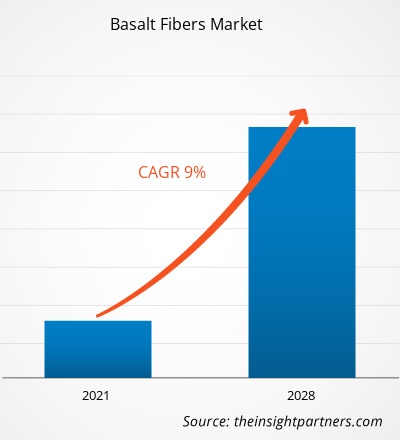2020 年玄武岩纤维市场价值为 2.16 亿美元,预计到 2028 年将达到 4.2714 亿美元;预计 2021 年至 2028 年的复合年增长率为 9.0%。
玄武岩纤维具有与玻璃纤维相似的化学性质,但物理化学性质优于玻璃纤维。由于汽车、船舶、建筑和电子等终端行业的需求,玄武岩纤维市场预计将出现高增长。由于人口增长、收入增加以及各经济体政府为发展更好的基础设施而采取的举措,多个地区的建筑活动增加,这可能会促进玄武岩纤维市场的增长。然而,原材料性能不一致是制约玄武岩纤维市场增长的因素之一。
2020 年,亚太地区在全球玄武岩纤维市场中占有最大份额。亚太大陆由印度、中国、日本、韩国和澳大利亚等多个发展中和发达经济体组成。新兴国家正在经历工业化和城镇化活动的激增。预计印度和中国等国家建设项目的增长以及对基础设施活动(例如新建高速公路、铁路、地铁线路和路面衬砌)的投资不断增加将推动该地区的玄武岩纤维市场。
定制此报告以满足您的需求
您可以免费定制任何报告,包括本报告的部分内容、国家级分析、Excel 数据包,以及为初创企业和大学提供优惠和折扣
- 获取此报告的关键市场趋势。这个免费样品将包括数据分析,从市场趋势到估计和预测。
COVID-19 疫情对玄武岩纤维市场的影响
持续的疫情彻底改变了化学和材料行业的现状,对玄武岩纤维市场的增长产生了负面影响。为抗击病毒传播而采取的措施影响了多个工业部门的增长。由于国家和国际边界突然关闭,运营效率突然扭曲和价值链中断,建筑、汽车、化工和电子等行业受到了影响。多个工业部门增长大幅下降,严重影响了全球市场对玄武岩纤维的需求。然而,随着各经济体计划恢复运营,预计全球对玄武岩纤维的需求将上升。建筑、汽车、化工、电子和航空航天等各个行业对玄武岩纤维的需求不断扩大,加上知名制造商的大量投资,预计将推动玄武岩纤维的增长。
市场洞察
玄武岩纤维在各种终端行业中的广泛应用推动其市场增长
玄武岩纤维在各种终端行业中有着广泛的应用,例如建筑、汽车、电气和电子、化学、航空航天和船舶。在建筑中,短切玄武岩纤维用于提高水泥板的抗开裂性。由于玄武岩纤维在极端条件下具有独特的化学稳定性,它们可用于许多混凝土结构,例如桥梁、隧道、水坝和地板。玄武岩纤维在化学工业中用于生产耐化学腐蚀的管道、防护涂层、腐蚀性液体、化肥、酸、有毒物质的储罐等。随着玄武岩纤维的应用不断深入,市场对玄武岩纤维的需求正在以更快的速度增长。
产品洞察
根据产品,全球玄武岩纤维市场细分为粗纱、短切原丝、加捻纱、织物和胶带等。2020 年,粗纱部分在全球玄武岩纤维市场中占有最大份额。玄武岩粗纱是一束连续的单向复合玄武岩纤维。粗纱具有耐恶劣环境、高自然强度、长使用寿命和优异的电绝缘性能。根据其技术特性,玄武岩粗纱在许多方面都优于 E 玻璃和 S 玻璃。玄武岩粗纱具有极高的耐热性,可在短时间内耐受高达 1,000°C 的温度。
Kamenny Vek Company;Fiberbas Construction and Building Technologies;Hydro Design Management Co. Pvt. Ltd.;Hg Gbf Basalt Fiber Co., Ltd;Bastech;Mafic SA;山西玄武岩纤维科技有限公司;Technobasalt-Invest LLC;Deutsche Basalt Faser Gmbh;和 Basalt Engineering LLC 是全球玄武岩纤维市场的主要参与者。
报告亮点
- 玄武岩纤维市场的渐进式行业趋势可帮助参与者制定有效的长期战略
- 发达市场和发展中市场采用的业务增长战略
- 2019年至2028年玄武岩纤维市场定量分析
- 全球玄武岩纤维需求量预测
- PEST 分析可说明行业内买家和供应商的效率
- 了解竞争市场状况的最新发展
- 市场趋势和前景以及推动和抑制玄武岩纤维市场增长的因素
- 通过强调支撑商业利益的市场策略来协助决策过程,从而促进市场增长
- 各节点玄武岩纤维市场规模规模
- 市场详细概述和细分,以及玄武岩纤维行业动态
- 各地区玄武岩纤维市场规模及增长潜力
玄武岩纤维市场区域洞察
Insight Partners 的分析师已详细解释了预测期内影响玄武岩纤维市场的区域趋势和因素。本节还讨论了北美、欧洲、亚太地区、中东和非洲以及南美和中美洲的玄武岩纤维市场细分和地理位置。

- 获取玄武岩纤维市场的区域特定数据
玄武岩纤维市场报告范围
| 报告属性 | 细节 |
|---|---|
| 2020 年市场规模 | 2.16亿美元 |
| 2028 年市场规模 | 4.2714亿美元 |
| 全球复合年增长率(2020 - 2028) | 9.0% |
| 史料 | 2018-2019 |
| 预测期 | 2021-2028 |
| 涵盖的领域 | 按类型
|
| 覆盖地区和国家 | 北美
|
| 市场领导者和主要公司简介 |
|
市场参与者密度:了解其对商业动态的影响
玄武岩纤维市场正在快速增长,这得益于终端用户需求的不断增长,而这些需求又源于消费者偏好的不断变化、技术进步以及对产品优势的认识不断提高等因素。随着需求的增加,企业正在扩大其产品范围,进行创新以满足消费者的需求,并利用新兴趋势,从而进一步推动市场增长。
市场参与者密度是指在特定市场或行业内运营的企业或公司的分布情况。它表明在给定市场空间中,相对于其规模或总市场价值,有多少竞争对手(市场参与者)存在。
在玄武岩纤维市场运营的主要公司有:
- Kamenny Vek 公司
- Fiberbas 建筑和建筑技术
- Hydro 设计管理有限公司
- 华工钢坯纤维有限公司
- 巴斯特克
免责声明:上面列出的公司没有按照任何特定顺序排列。

- 了解玄武岩纤维市场主要参与者概况
全球玄武岩纤维市场
按产品
- 粗纱
- 短切丝
- 加捻纱
- 织物和胶带
- 其他的
按最终用途行业
- 建造
- 汽车
- 电气和电子
- 化学
- 其他的
公司简介
- Kamenny Vek 公司
- Fiberbas 建筑和建筑技术
- Hydro 设计管理有限公司
- 华工钢坯纤维有限公司
- 巴斯特克
- 镁铁质公司
- 山西玄武岩纤维科技有限公司
- Technobasalt-Invest LLC
- 德国玄武岩纤维有限公司
- 玄武岩工程有限责任公司
- 历史分析(2 年)、基准年、预测(7 年)及复合年增长率
- PEST 和 SWOT 分析
- 市场规模价值/数量 - 全球、区域、国家
- 行业和竞争格局
- Excel 数据集



Report Coverage
Revenue forecast, Company Analysis, Industry landscape, Growth factors, and Trends

Segment Covered
This text is related
to segments covered.

Regional Scope
North America, Europe, Asia Pacific, Middle East & Africa, South & Central America

Country Scope
This text is related
to country scope.
常见问题
Asia-Pacific is estimated to register the fastest CAGR in the market over the forecast period. Asia Pacific comprises several economies such as India, China, Japan, South Korea, and Australia. These countries are witnessing an upsurge in industrialization and urbanization activities, offering ample opportunities for the key market players in the basalt fiber market. In Asia Pacific, there has been an increase in the consumption of basalt fiber in various industries, such as wind energy, construction & infrastructure, electrical & electronics, and automotive. Along with this, the rise in awareness regarding sustainable living and environment-friendly materials used in the application of infrastructure, aerospace, and other industries boosts the demand for basalt fibers in the region. Features of basalt fiber such as low cost, easy availability, and increasing production capacities bolster the growth of the basalt fiber market in Asia Pacific.
Based on end-use industry, automotive segment led the global basalt fiber market during the forecasted period. Basalt fiber has various properties such as high mechanical strength, resistance to high temperature, durability, and chemical resistance. It is also environmentally friendly. Such properties make basalt fiber an ideal material to be used in the automotive industry to produce headliners, CNG cylinders, brake pads and clutch plates, thermo insulation for exhaust systems, muffler’s filler, interior and exterior parts, and thermoplastic parts. Basalt fiber is lighter than steel. The fiber has high mechanical strength and an extended range of working temperatures. It is cost-effective along with excellent recyclability. All these properties made basalt fiber one of the ideal materials to be used to produce CNG cylinders.
On the basis of end-use industry, construction segment is leading the basalt fiber market during the forecast period. Basalt fibers are primarily employed in the construction industry as it has a higher strength than steel and is resistant to electromagnetic radiations and ultraviolet rays. Basalt fiber is three times lighter than steel and is 2.5 times stronger in tensile strength than steel. It also has an extremely lower coefficient of heat conductivity than steel, which improves energy efficiency. In the construction industry, basalt fiber is used in various applications, such as in the usage of wet or dry chopped strand for premix technology, basalt roving for spray up and shotcrete technologies, high strength roving for the manufacturing of rebars and pultruded profiles, and basalt fiber fabrics for concrete reinforcement and building thermo insulation.
Based on product, fabrics and tapes segment is expected to grow at the fastest CAGR from 2021 to 2028. Basalt woven and knitted fabrics are mostly manufactured from direct roving, twisted yarns, special weaving, and knitting machines. Basalt fabrics are generally used for producing structural-basalt plastics, which are based on various thermosetting binders. It can also be used as a base when manufacturing soft and rigid roofing as well as for electrotechnical purposes to produce insulation materials. The basalt fiber tapes are used with resin and are compatible with polyester, epoxy, and vinyl ester. These tapes are used for the selective reinforcement of laminates, sleeve or pipe winding, seams, and molding. The finished edges of the basalt fiber provide easy handling and a clean, finished appearance, which prevents the tape from unraveling.
The major players operating in the basalt fiber market are Kamenny Vek Company, Fiberbas Construction and Building Technologies, Hydro Design Management Co. Pvt. Ltd., Hg Gbf Basalt Fiber Co., Ltd., Bastech, Mafic SA, Shanxi Basalt Fiber Technology Co. Ltd., Technobasalt-Invest LLC, Deutsche Basalt Faser Gmbh, and Basalt Engineering LLC.
In 2020, Asia-Pacific held the largest revenue share of the global basalt fiber market. Asia-Pacific continent comprises several developing and developed economies such as India, China, Japan, South Korea, and Australia. These emerging countries are witnessing an upsurge in industrialization and urbanization activities, offering ample opportunities for the key market players in the basalt fiber market. Asia-Pacific region is anticipated to propel the basalt fiber demand owing to the presence of several domestic players in the vertical market segment such as construction and automotive. The basalt fiber market is expected to witness huge demand from the construction and automotive industries due to their resistance power to varying temperatures and chemicals, low water absorption, high mechanical strength, and durability. Besides, basalt fiber finds applications in marine, aerospace & defense, and others. The basalt fiber market is expected to rise during the projection period due to enormous growth in the automotive sector especially in countries including India and China. Additionally, the rising urbanization, rising population, and the presence of government support are the other drivers for the market growth in the region.
Trends and growth analysis reports related to Chemicals and Materials : READ MORE..
The List of Companies - Basalt Fiber Market
- Kamenny Vek Company
- Fiberbas Construction and Building Technologies
- Hydro Design Management Co. Pvt. Ltd.
- Hg Gbf Basalt Fiber Co., Ltd
- Bastech
- Mafic SA
- Shanxi Basalt Fiber Technology Co. Ltd
- Technobasalt-Invest LLC
- Deutsche Basalt Faser Gmbh
- Basalt Engineering LLC
The Insight Partners performs research in 4 major stages: Data Collection & Secondary Research, Primary Research, Data Analysis and Data Triangulation & Final Review.
- Data Collection and Secondary Research:
As a market research and consulting firm operating from a decade, we have published and advised several client across the globe. First step for any study will start with an assessment of currently available data and insights from existing reports. Further, historical and current market information is collected from Investor Presentations, Annual Reports, SEC Filings, etc., and other information related to company’s performance and market positioning are gathered from Paid Databases (Factiva, Hoovers, and Reuters) and various other publications available in public domain.
Several associations trade associates, technical forums, institutes, societies and organization are accessed to gain technical as well as market related insights through their publications such as research papers, blogs and press releases related to the studies are referred to get cues about the market. Further, white papers, journals, magazines, and other news articles published in last 3 years are scrutinized and analyzed to understand the current market trends.
- Primary Research:
The primarily interview analysis comprise of data obtained from industry participants interview and answers to survey questions gathered by in-house primary team.
For primary research, interviews are conducted with industry experts/CEOs/Marketing Managers/VPs/Subject Matter Experts from both demand and supply side to get a 360-degree view of the market. The primary team conducts several interviews based on the complexity of the markets to understand the various market trends and dynamics which makes research more credible and precise.
A typical research interview fulfils the following functions:
- Provides first-hand information on the market size, market trends, growth trends, competitive landscape, and outlook
- Validates and strengthens in-house secondary research findings
- Develops the analysis team’s expertise and market understanding
Primary research involves email interactions and telephone interviews for each market, category, segment, and sub-segment across geographies. The participants who typically take part in such a process include, but are not limited to:
- Industry participants: VPs, business development managers, market intelligence managers and national sales managers
- Outside experts: Valuation experts, research analysts and key opinion leaders specializing in the electronics and semiconductor industry.
Below is the breakup of our primary respondents by company, designation, and region:

Once we receive the confirmation from primary research sources or primary respondents, we finalize the base year market estimation and forecast the data as per the macroeconomic and microeconomic factors assessed during data collection.
- Data Analysis:
Once data is validated through both secondary as well as primary respondents, we finalize the market estimations by hypothesis formulation and factor analysis at regional and country level.
- Macro-Economic Factor Analysis:
We analyse macroeconomic indicators such the gross domestic product (GDP), increase in the demand for goods and services across industries, technological advancement, regional economic growth, governmental policies, the influence of COVID-19, PEST analysis, and other aspects. This analysis aids in setting benchmarks for various nations/regions and approximating market splits. Additionally, the general trend of the aforementioned components aid in determining the market's development possibilities.
- Country Level Data:
Various factors that are especially aligned to the country are taken into account to determine the market size for a certain area and country, including the presence of vendors, such as headquarters and offices, the country's GDP, demand patterns, and industry growth. To comprehend the market dynamics for the nation, a number of growth variables, inhibitors, application areas, and current market trends are researched. The aforementioned elements aid in determining the country's overall market's growth potential.
- Company Profile:
The “Table of Contents” is formulated by listing and analyzing more than 25 - 30 companies operating in the market ecosystem across geographies. However, we profile only 10 companies as a standard practice in our syndicate reports. These 10 companies comprise leading, emerging, and regional players. Nonetheless, our analysis is not restricted to the 10 listed companies, we also analyze other companies present in the market to develop a holistic view and understand the prevailing trends. The “Company Profiles” section in the report covers key facts, business description, products & services, financial information, SWOT analysis, and key developments. The financial information presented is extracted from the annual reports and official documents of the publicly listed companies. Upon collecting the information for the sections of respective companies, we verify them via various primary sources and then compile the data in respective company profiles. The company level information helps us in deriving the base number as well as in forecasting the market size.
- Developing Base Number:
Aggregation of sales statistics (2020-2022) and macro-economic factor, and other secondary and primary research insights are utilized to arrive at base number and related market shares for 2022. The data gaps are identified in this step and relevant market data is analyzed, collected from paid primary interviews or databases. On finalizing the base year market size, forecasts are developed on the basis of macro-economic, industry and market growth factors and company level analysis.
- Data Triangulation and Final Review:
The market findings and base year market size calculations are validated from supply as well as demand side. Demand side validations are based on macro-economic factor analysis and benchmarks for respective regions and countries. In case of supply side validations, revenues of major companies are estimated (in case not available) based on industry benchmark, approximate number of employees, product portfolio, and primary interviews revenues are gathered. Further revenue from target product/service segment is assessed to avoid overshooting of market statistics. In case of heavy deviations between supply and demand side values, all thes steps are repeated to achieve synchronization.
We follow an iterative model, wherein we share our research findings with Subject Matter Experts (SME’s) and Key Opinion Leaders (KOLs) until consensus view of the market is not formulated – this model negates any drastic deviation in the opinions of experts. Only validated and universally acceptable research findings are quoted in our reports.
We have important check points that we use to validate our research findings – which we call – data triangulation, where we validate the information, we generate from secondary sources with primary interviews and then we re-validate with our internal data bases and Subject matter experts. This comprehensive model enables us to deliver high quality, reliable data in shortest possible time.


 获取此报告的免费样本
获取此报告的免费样本